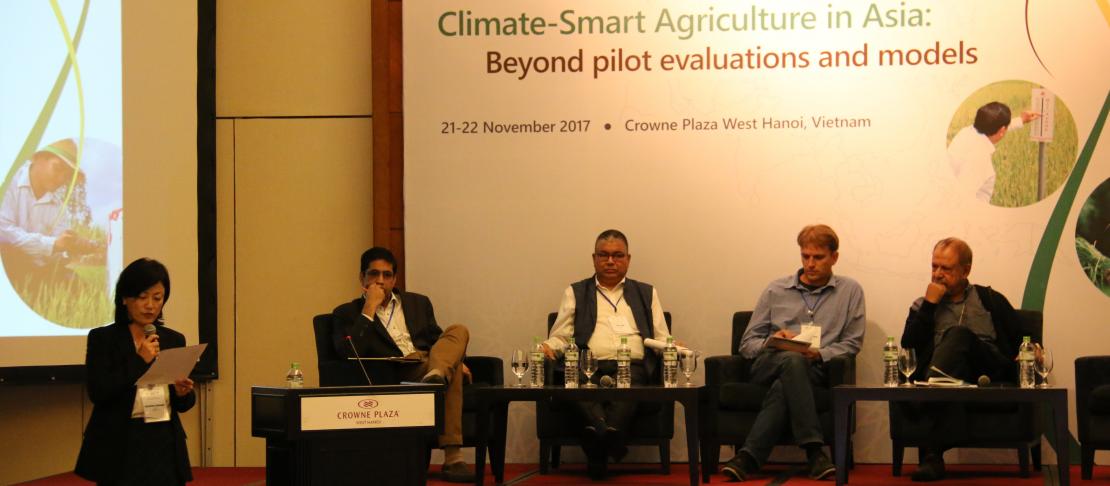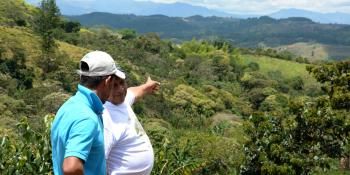Climate-smart agriculture in Asia: Beyond pilot evaluations and models

A joint conference held in Vietnam has provided a platform for discussions about the scaling up and out of climate-smart agricultural practices in Asia.
The CGIAR Research Program on Climate Change, Agriculture and Food Security (CCAFS), South Asia and Southeast Asia, collaboratively organized a conference titled ‘Climate-smart agriculture in Asia: Beyond pilot evaluations and models’ in Hanoi, Vietnam between 21 and 23 November. Witnessing in action scientific experts as well as national partners, the deliberations have led to the initiation of important dialogue to assess the ways and means of scaling climate-smart agricultural (CSA) practices in Asia.
With more than a 100 participants, the discussions were designed to include the experience of national partners as well as suggestions and measures to take the lessons learnt from pilots to further the scaling of climate-smartness in agriculture in the region. The conference was inaugurated by the regional program leaders of South Asia and Southeast Asia, wherein the participants were welcomed to indulge in plenary sessions focused on (i) identifying the scalable CSA options and methods of scaling them out; (ii) identify key selling points of CSA and its value for banks and development partners; and (iii) establish ways to make CSA research for development responsive to upscaling and big investment in Asia.
Assessing ways to make agriculture climate-smart at scale
Day one of the conference began with a plenary lecture on ‘making agriculture climate-smart at scale’ where the exponential potential of technological innovations in bringing it about was emphasized. This was followed by panel discussions on the CSA technologies scalable in Asia, designing and implementation of good crop insurance program for climate risk management and finally the hype or reality built around the potential of climate information services. With regards to the scalable CSA technologies in the region, experts from different fields shared their experiences with successful outcomes from water and ecosystem services, especially the model of solar water pump cooperatives in the Climate-Smart Villages of India and Nepal; aquaculture helping income generation and resilience among coastal communities; support mechanism being built around the scaling of agroforestry and livestock research.
A unanimous opinion appeared to have been built around crop insurance being one of the ways of risk mitigation, and thereby the need to design integrated risk management programs promoting bundling of climate-smart technologies. Further, the plenary discussion on the hype created around risk management through climate information services was rooted in the ‘realpolitik’ of weather risks and how in such scenarios, technically savvy climate information services can be a major way forward.
From impactful research to deploying big data-way forward for scaling CSA
Day two began with a summary discussion of the preceding day followed by a plenary lecture on four cases of upscaling CSA, namely, climate risk-based cropping calendar for Mekong River Delta; climate-smart agroforestry; scaling CSVs in Nepal; and, strengthening public-private partnerships for scaling CSVs in India. Subsequently, a plenary session ensued on ways to make CSA research and development more responsive to upscaling and big investments. The lead presenter called attention to the conditions for success in terms of upscaling CSA. He emphasized the importance of infrastructure creation along with an enabling policy environment to achieve that end. Returns of investments have to be well thought out or mechanisms of subsidies and incentives have to be resorted to since a lot of climate-related outcomes (carbon sequestration, GHG mitigation etc.) are social and not private benefits. Even further, some investments have a low commercial viability but high economic impact. This gap must be filled especially through the public-private partnership mode. Finally, convergence was seen as the best solution to invest more in CSA technologies.
One of the fascinating presentations was made on opportunities for Big Data in CSA. With the supersonic speed with which technology-driven transformations have taken place in the recent past, a tabula rasa exists in terms of big data application for furthering CSA, given the fact that no data ecosystem currently exists at the moment. It was pointed out that the CGIAR itself surveys around 180,000 smallholder households annually, and infusing this process with technology-driven solutions will lead to astonishing results. Some of the examples of Big Data integration in CSA provided were data mining for CSA priority setting, digital advisory services, personalization of information among others. Discussions on day two concluded with a roundtable discussion on what would make CSA a good investment.
On the whole, the conference served as a highly enticing platform by bringing together a crew of climate and food security experts who enriched the gathering with some highly valuable insights as to the way forward to scale up and out climate-smartness in agriculture in Asia.
Shehnab Sahin is the Communications Specialist for CCAFS South Asia



